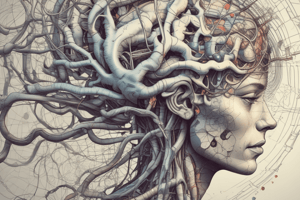Podcast
Questions and Answers
Which brain region controls eye movements?
Which brain region controls eye movements?
- LGN
- Thalamus
- AOS
- Superior Colliculus (correct)
What is the function of the Thalamus LGN?
What is the function of the Thalamus LGN?
- It relays visual information to the brain.
- It organizes visual information from the two eyes. (correct)
- It controls eye movements.
- It detects specific features in the visual cortex.
Which type of information is sent quickly to the brain through the Magno pathway?
Which type of information is sent quickly to the brain through the Magno pathway?
- Information about where the object is. (correct)
- Information about what the object is.
- Information about size.
- Information about color.
Which brain region is responsible for telling you the time?
Which brain region is responsible for telling you the time?
What feature does V1 in the visual cortex detect?
What feature does V1 in the visual cortex detect?
What type of information does the Parvo pathway send to the brain?
What type of information does the Parvo pathway send to the brain?
Which brain region is responsible for organizing visual information in terms of category?
Which brain region is responsible for organizing visual information in terms of category?
What type of cells in the retina and LGN like circles?
What type of cells in the retina and LGN like circles?
What happens to the signal after it leaves the retina?
What happens to the signal after it leaves the retina?
What does the Occipital Lobe of the Cortex do?
What does the Occipital Lobe of the Cortex do?
Which area of the visual cortex is responsible for processing basic shape and color?
Which area of the visual cortex is responsible for processing basic shape and color?
What is the term used to describe the holistic perception of the entire visual image being processed as a whole?
What is the term used to describe the holistic perception of the entire visual image being processed as a whole?
Which principle of grouping helps the nervous system organize sensory input based on objects' proximity to each other?
Which principle of grouping helps the nervous system organize sensory input based on objects' proximity to each other?
Which type of constancy refers to the perception that familiar objects have a consistent color, even if changing illuminations alter the wavelength reflected?
Which type of constancy refers to the perception that familiar objects have a consistent color, even if changing illuminations alter the wavelength reflected?
Which theory suggests that object recognition is based on identifying key features and the holistic perception of the whole face?
Which theory suggests that object recognition is based on identifying key features and the holistic perception of the whole face?
What is the term used to describe the difficulty in recognizing faces when they are presented upside down or inverted?
What is the term used to describe the difficulty in recognizing faces when they are presented upside down or inverted?
Which visual disorder is characterized by damage to the right parietal lobe, causing the left side of the visual field to be neglected or ignored?
Which visual disorder is characterized by damage to the right parietal lobe, causing the left side of the visual field to be neglected or ignored?
Which visual disorder is characterized by the inability to recognize familiar objects, known as aperceptive agnosia?
Which visual disorder is characterized by the inability to recognize familiar objects, known as aperceptive agnosia?
Which visual disorder is characterized by the inability to recognize faces, known as prosopagnosia?
Which visual disorder is characterized by the inability to recognize faces, known as prosopagnosia?
Which visual disorder is characterized by the inability to perceive motion, known as akinetopsia?
Which visual disorder is characterized by the inability to perceive motion, known as akinetopsia?
Flashcards are hidden until you start studying



